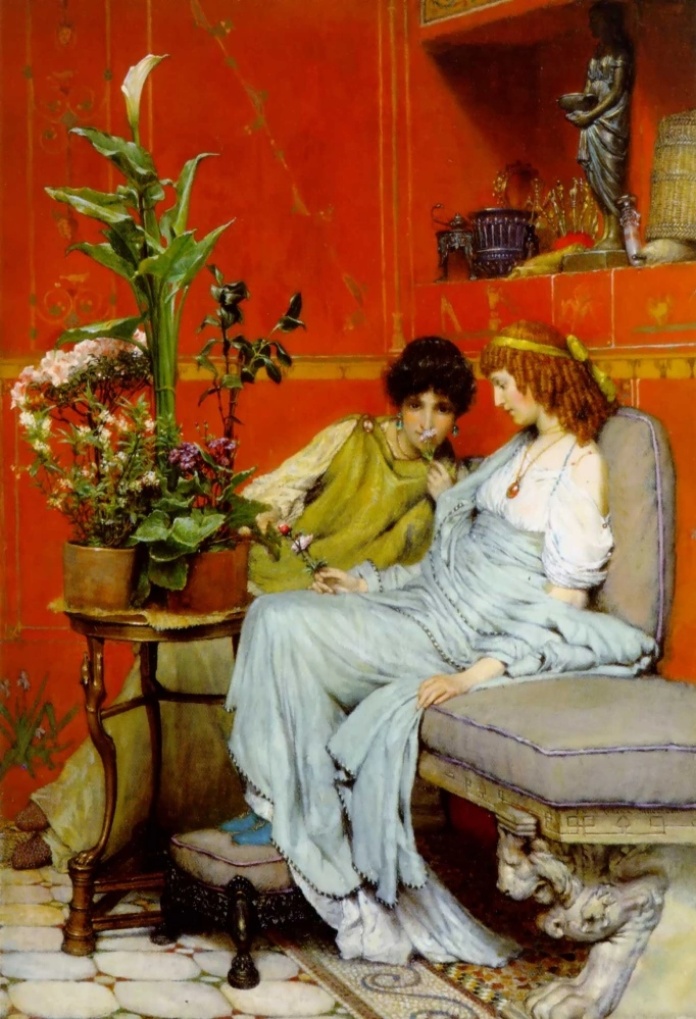Artist Sir Lawrence Alma-Tadema
Sir Lawrence Alma-Tadema (niderl Lourens Alma Tadema, English.. Lawrence Alma-Tadema ; 1836 Dronteyp - 1912, Wiesbaden) - British artist of Dutch origin, he painted historical and mythological subjects. He became famous for his descriptions of the luxury and decline of the Roman Empire, the landscapes of the Mediterranean. His paintings accurately recreated the details of a bygone era and were very popular in Great Britain, as evidenced by the fact that he was knighted in 1899. After the death of Alma-Tadema, he was forgotten, and only in the 1960s, with the rise of interest in salon and decorative painting, his contribution to the development of British and world art was appreciated.
Lawrence Alma Tadema was born on January 8, 1836 in the small village of Dronrijp, in Friesland in the north of the Netherlands. The sixth child of the village notary Peter Tadem and the third child from his second wife, Hinke Dirks Brauer, who was the half-sister of P. Tadem's first wife. Tadema is an old Frisian surname meaning "Adam's son." The names Lawrence and Alma were given by his godparents, but after moving to the UK, the middle name was included in the surname in order to appear in the exhibition catalogs at the very beginning.
In 1838, the Tadema family moved to Leeuwarden, where the notary earned more money. Lawrence was orphaned at the age of 4. His mother had a penchant for art, and decided that the children should learn to draw, Lawrence received his first lessons with his older half-brothers from a local artist. It was supposed to give him a law degree, but at the age of 15 he was diagnosed with consumption. After that, awaiting death, he intensively engaged in graphics and painting. Having recovered, Lawrence decided to devote his life to art and become an artist. In 1852 he entered the Royal Academy of Antwerp, where he studied for four years. His main mentor was Egidius Vappers, Alma-Tadema received several awards for his achievements in teaching. He also assisted Professor Ludwik Jan de Teije, where he took courses in history and historical costume;
1861_Parenting the Children of Clovis (School of Revenge, Teaching the Sons of Clotilde)
In November 1858, Alma-Tadema began working with the artist Hendrik Leys, whose school was one of the most famous in Belgium. Under his leadership, Alma-Tadema in 1861 wrote his first large-scale work - "Teaching the Children of Clovis", exhibited at the academic exhibition in Antwerp. The success of the work laid the foundation for the artist's further popularity, the picture was approved not only by critics and colleagues in the art workshop, but also by King Leopold.
In the early 1860s, Alma-Tadem's favorite theme was the Merovingian era. However, these paintings were not very popular, despite the romantic plots and confident transmission of feelings. The artist switched to themes from the history of ancient Egypt. In 1862, Alma-Tadema left Leis's studio and since then worked independently, gradually becoming an academic artist of the European level.
In 1863, Alma-Tadema's mother died (January 3), and on September 24, he married the Frenchwoman Marie-Pauline Dumoulin. They spent their honeymoon in Italy, visiting Florence, Rome, Naples and Pompeii. The couple had three children, but their only son died a few months after birth from smallpox. Daughters - Laurence (1864-1940) and Anne (1867-1943), had artistic inclinations, one became a writer, the other - an artist; both never got married. Alma-Tadema painted his wife in different images; three of her portraits are also known. A trip to Italy radically changes the theme of Alma-Tadema's work, from now on he developed plots from the ancient history of Greece and ancient Rome. 1887_ Women of Amphissa
In 1864, Alma-Tadema met Ernest Gambar, an influential Belgian publisher and art dealer. Gambar was impressed by the artist's ancient Egyptian paintings, ordered him a series of 24 canvases and arranged his first exhibition in London. In 1865, Alma-Tadema moved to Brussels, where he was soon awarded the Order of Leopold. On May 28, 1869, Alma-Tadema's wife died of smallpox at the age of 32. After that, the artist could not do anything for four months, his daughters (they were 5 and 2 years old) were cared for by his elder sister, Atje Tadema (Dutch. Atje Tadema, 1834-1876), who lived with them until her marriage in 1873.
Health problems forced Alma-Tadema to move to England - Belgian doctors were unable to diagnose. On the recommendation of Gambar, in December 1869 the artist arrived in London, where he was received at the house of the artist Ford Brown. At Brown's house, he met his future second wife, Laura Teresa Epps, Brown's sister-in-law.
With the outbreak of the Franco-Prussian war, Alma-Tadema finally moved to England with his daughters and sister. He began to actively communicate with Laura Epps, becoming her painting teacher. Father - Dr. Epps, at first was against their relationship - the artist was 34 years old, his student - 18, but in July 1871 Alma-Tadema married a second time. Laura herself became a famous artist, and has always served as a model for his paintings (for example, "The Women of Amfissa"). Alma-Tadema's second marriage was childless.
1863_Who's There (Curious)
Since 1870, Alma-Tadema has lived permanently in the UK, where his career took place, most of his customers lived; he became one of the most famous and highly paid artists of the Victorian era. With his marriage, he was accepted into the circle of the Pre-Raphaelites, under their influence his palette changed - it became lighter, and the writing technique also changed.
In 1872, Alma-Tadema organized a catalog of his works, where each picture had an opus number (like that of composers) - in chronological order, was recorded in a photograph and provided with his personal signature. This made it possible to track the fate of the paintings and to protect the artist's work from counterfeiting.
On June 19, 1879, Alma-Tadema received the title of full academician of the Royal Academy of Arts, which was the most significant of his awards. In 1882, he organized a large retrospective exhibition at the Grosvenor Gallery in London, which featured 287 works. Critics' reviews were controversial, negative emotions provoked "unnecessary archaeological details" and dryness in the transmission of emotions.
1888_Roses of Heliogabalus
In 1888, one of his most famous paintings, The Roses of Heliogabalus, was created. It was based on an episode from the Biographies of Augustus: the depraved emperor Heliogabalus at orgies so overwhelmed his guests with cascades of rose petals that some were suffocating under them. The painting was painted for four months in winter, and during all this time the artist was sent weekly fresh roses from the French Riviera and even from Africa.
In 1883, Alma-Tadema moved to a new house, which was built in the ancient Roman style, and exactly corresponded to the ancient canons. His images are found in many of Alma-Tadema's works. Due to the hassle of home decoration and obsessive perfectionism, the artist's productivity has declined; health also deteriorated. Nevertheless, in 1889, Alma-Tadema was awarded the Gold Medal at the World Exhibition in Paris, in 1890 he was elected an honorary member of the Drama Society of the University of Oxford, and in 1897 - the Great Gold Medal at the International Exhibition in Brussels. On May 24, 1899 (Queen Victoria's 81st birthday), he was knighted, becoming only the eighth foreign artist to be honored. Among his predecessors were Rubens and Van Dyck. In 1900, during the next World Exhibition in Paris, he helped organize the British section, and exhibited two of his works, which received a large gold medal. He also participated in the organization of the World Exhibition in St. Louis in 1904. He continued to travel: in the winter of 1902-1903 he made a long trip to Egypt, where he witnessed the opening of the first Aswan Dam.
In addition to painting, Alma-Tadema actively participated in the design of theatrical performances, created models of costumes, furniture in the Pompeian or Ancient Egyptian style, made book illustrations, drawings of fabrics and picture frames. Many of his design findings were later captured on canvases. And in the 1900s, he remained creative, continued to create large paintings, for example, "The Discovery of Moses" (1904).
In the last decades of his life, the creative manner of Alma-Tadema was influenced by European Symbolists, and he himself had a certain influence on Gustav Klimt and Fernand Knopf.
During his lifetime, Alma-Tadema was a successful businessman and one of the most prosperous Victorian painters. This was achieved in many ways: he pleased the tastes of his contemporaries, depicting Victorians in a classic setting, as well as the decorativeness of his works, where there is a lot of marble, sunlight, and so on. In many ways, Alma-Tadema's paintings allowed the Victorians to identify with the Romans of the heyday of the empire.
1877_The Finding of Moses A
sad irony - paintings that Victorians considered outstanding works of art, just a few decades later turned into pornography and began to decorate the bedroom of prostitutes.
In the late 1960s, director and producer Allen Pound gathered a large collection of Alma-Tadema's paintings (35 works), but in 1973, after being ruined, he was forced to sell it at Sotheby's. Since that time, interest in Alma-Tadema has revived in the antique market. In this regard, the fate of the painting "Finding Moses" is characteristic. In 1904, a buyer paid 5,250 pounds for it, in 1935 it was sold for 861 pounds, and in 1960 for 252 pounds. During the 1973 Pound Collection Sale, the Moses sold for £ 30,000. In May 1995 at Christie's auction the painting was sold for £ 1.5 million. In 2010, the painting was again sold for $ 3,592,500 to an anonymous buyer. 1885_A Meeting of Antony and Cleopatra
Alma-Tadema set a new record at Sotheby's in 2011: his painting "The Meeting of Antony and Cleopatra" was sold for $ 29.2 million. 1878_Oaks in Kidbrook Park

















































































































Aucun commentaire:
Enregistrer un commentaire